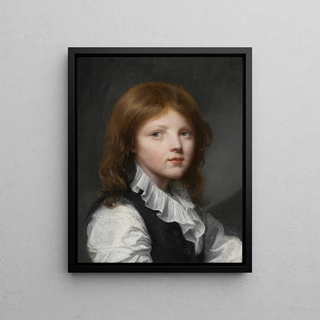Art print | Portrait of a boy in a black vest turned to the right - Jean-Baptiste Greuze


View from behind

Frame (optional)
In the fascinating world of 18th-century painting, the "Portrait of a Boy in a Black Waistcoat Turned to the Right" by Jean-Baptiste Greuze stands out for its ability to capture innocence and the liveliness of childhood. This iconic artwork, created by a master of portraiture, immerses us in a suspended moment where the expression of the young boy seems to tell a story. The artist, known for his skill in grasping the nuances of human emotions, invites us to contemplate the depth of the child's soul through delicate features and the brilliance of colors. As we approach this art print, we are transported to a world where time appears to stand still, and where each exchanged glance becomes an open window into human sensitivity.
Style and uniqueness of the work
Greuze's style is characterized by a realistic and intimate approach, making each portrait a meticulous psychological study. In this piece, the boy, dressed in a black waistcoat, slightly turns to the right, creating a dynamic that immediately draws the viewer's eye. The interplay of light and shadow sculpt his face, highlighting the softness of his features and the intensity of his gaze. The color palette chosen by Greuze, subtle and refined, contributes to the tender atmosphere emanating from this painting. Details such as the texture of the waistcoat and the brightness of the eyes are rendered with such precision that they seem almost tangible. This portrait is not limited to a simple physical representation; it transcends realism to offer a poetic vision of childhood, a tribute to the fleeting beauty of this life stage.
The artist and his influence
Jean-Baptiste Greuze, an emblematic figure of French painting, managed to leave his mark on his era with his unparalleled talent and artistic vision. Born in 1725, he established himself in the artistic world thanks to his ability to combine technique and emotion. Greuze was a pioneer in portrait art, moving away from the academic conventions of his time to explore more personal and intimate themes. His influence extends well beyond his

Matte finish

View from behind

Frame (optional)
In the fascinating world of 18th-century painting, the "Portrait of a Boy in a Black Waistcoat Turned to the Right" by Jean-Baptiste Greuze stands out for its ability to capture innocence and the liveliness of childhood. This iconic artwork, created by a master of portraiture, immerses us in a suspended moment where the expression of the young boy seems to tell a story. The artist, known for his skill in grasping the nuances of human emotions, invites us to contemplate the depth of the child's soul through delicate features and the brilliance of colors. As we approach this art print, we are transported to a world where time appears to stand still, and where each exchanged glance becomes an open window into human sensitivity.
Style and uniqueness of the work
Greuze's style is characterized by a realistic and intimate approach, making each portrait a meticulous psychological study. In this piece, the boy, dressed in a black waistcoat, slightly turns to the right, creating a dynamic that immediately draws the viewer's eye. The interplay of light and shadow sculpt his face, highlighting the softness of his features and the intensity of his gaze. The color palette chosen by Greuze, subtle and refined, contributes to the tender atmosphere emanating from this painting. Details such as the texture of the waistcoat and the brightness of the eyes are rendered with such precision that they seem almost tangible. This portrait is not limited to a simple physical representation; it transcends realism to offer a poetic vision of childhood, a tribute to the fleeting beauty of this life stage.
The artist and his influence
Jean-Baptiste Greuze, an emblematic figure of French painting, managed to leave his mark on his era with his unparalleled talent and artistic vision. Born in 1725, he established himself in the artistic world thanks to his ability to combine technique and emotion. Greuze was a pioneer in portrait art, moving away from the academic conventions of his time to explore more personal and intimate themes. His influence extends well beyond his






